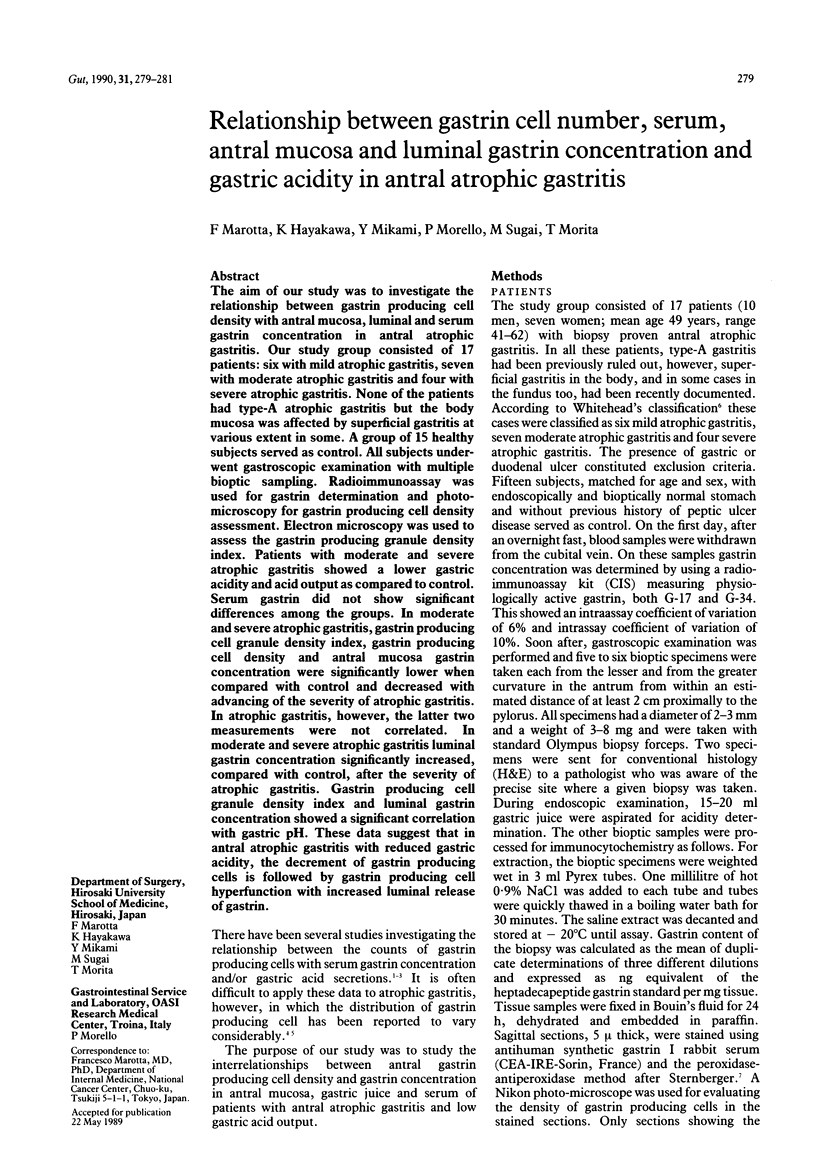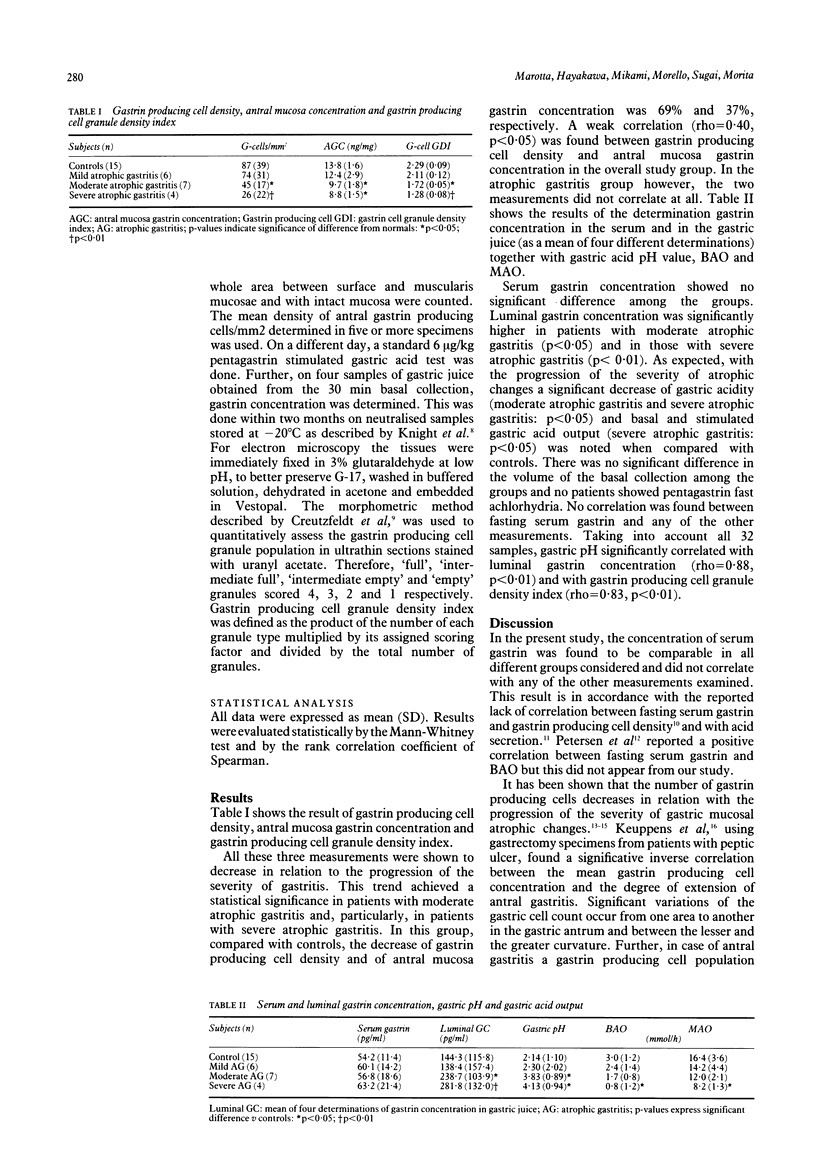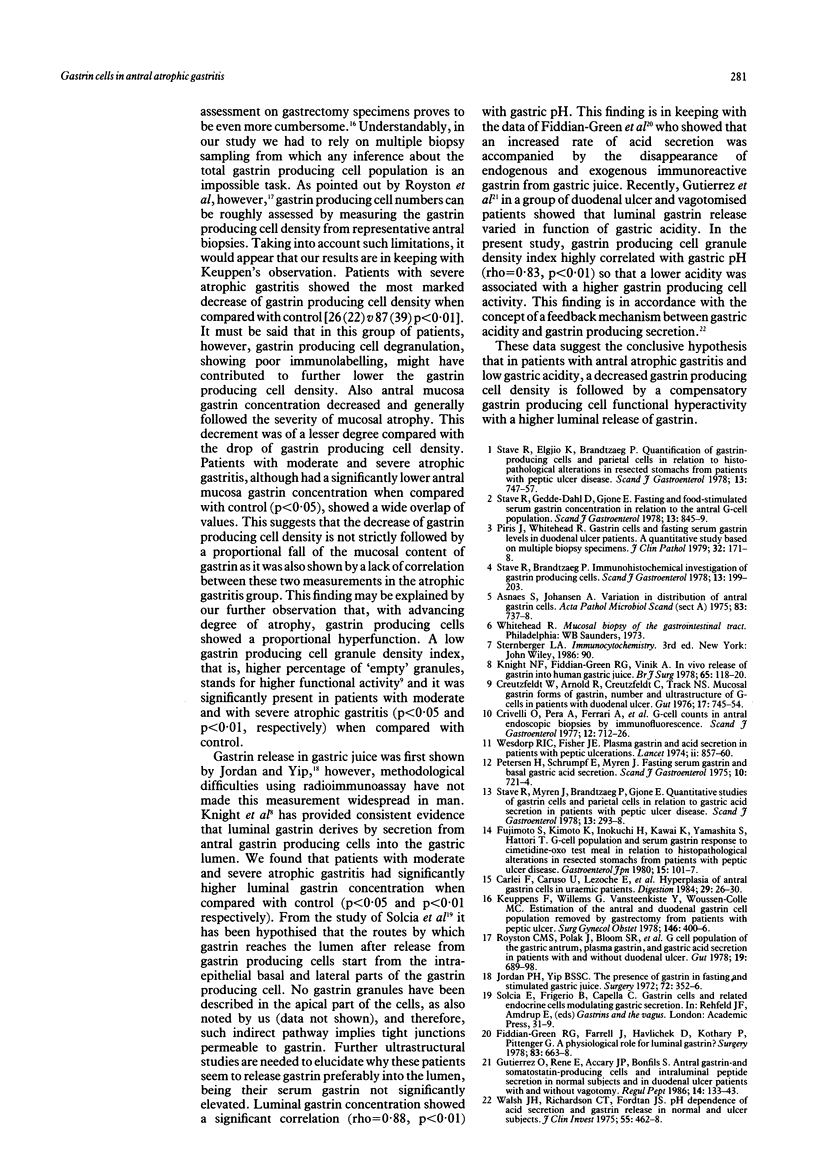Abstract
The aim of our study was to investigate the relationship between gastrin producing cell density with antral mucosa, luminal and serum gastrin concentration in antral atrophic gastritis. Our study group consisted of 17 patients: six with mild atrophic gastritis, seven with moderate atrophic gastritis and four with severe atrophic gastritis. None of the patients had type-A atrophic gastritis but the body mucosa was affected by superficial gastritis at various extent in some. A group of 15 healthy subjects served as control. All subjects underwent gastroscopic examination with multiple bioptic sampling. Radioimmunoassay was used for gastrin determination and photomicroscopy for gastrin producing cell density assessment. Electron microscopy was used to assess the gastrin producing granule density index. Patients with moderate and severe atrophic gastritis showed a lower gastric acidity and acid output as compared to control. Serum gastrin did not show significant differences among the groups. In moderate and severe atrophic gastritis, gastrin producing cell granule density index, gastrin producing cell density and antral mucosa gastrin concentration were significantly lower when compared with control and decreased with advancing of the severity of atrophic gastritis. In atrophic gastritis, however, the latter two measurements were not correlated. In moderate and severe atrophic gastritis luminal gastrin concentration significantly increased, compared with control, after the severity of atrophic gastritis. Gastrin producing cell granule density index and luminal gastrin concentration showed a significant correlation with gastric pH. These data suggest that in antral atrophic gastritis with reduced gastric acidity, the decrement of gastrin producing cells is followed by gastrin producing cell hyperfunction with increased luminal release of gastrin.
Full text
PDF


Selected References
These references are in PubMed. This may not be the complete list of references from this article.
- Asnaes S., Johansen A. Variation in distribution of antral gastrin cells. Acta Pathol Microbiol Scand A. 1975 Nov;83(6):737–738. doi: 10.1111/j.1699-0463.1975.tb01405.x. [DOI] [PubMed] [Google Scholar]
- Carlei F., Caruso U., Lezoche E., Ruscitto G., Lackie P., Casciani U., Speranza V., Polak J. M. Hyperplasia of antral G cells in uraemic patients. Digestion. 1984;29(1):26–30. doi: 10.1159/000199004. [DOI] [PubMed] [Google Scholar]
- Creutzfeldt W., Arnold R., Creutzfeldt C., Track N. S. Mucosal gastrin concentration, molecular forms of gastrin, number and ultrastructure of G-cells in patients with duodenal ulcer. Gut. 1976 Oct;17(10):745–754. doi: 10.1136/gut.17.10.745. [DOI] [PMC free article] [PubMed] [Google Scholar]
- Fiddian-Green R. G., Farrell J., Havlichek D., Jr, Kothary P., Pittenger G. A physiological role for luminal gastrin? Surgery. 1978 Jun;83(6):663–668. [PubMed] [Google Scholar]
- Fujimoto S., Kimoto K., Inokuchi H., Kawai K., Yamashita S., Hattori T. G-cell population and serum gastrin response to cimetidine-OXO test meal in relation to histopathological alterations in resected stomachs from patients with peptic ulcer disease. Gastroenterol Jpn. 1980 Apr;15(2):101–107. doi: 10.1007/BF02774921. [DOI] [PubMed] [Google Scholar]
- Gutiérrez O., René E., Accary J. P., Lehy T., Laigneau J. P., Chayvialle J. A., Bonfils S. Antral gastrin- and somatostatin-producing cells and intraluminal peptide secretion in normal subjects and duodenal ulcer patients with and without vagotomy. Regul Pept. 1986 Apr;14(2):133–143. doi: 10.1016/0167-0115(86)90214-4. [DOI] [PubMed] [Google Scholar]
- Jordan P. H., Jr, Yip B. S. The presence of gastrin in fasting and stimulated gastric juice of man. Surgery. 1972 Sep;72(3):352–356. [PubMed] [Google Scholar]
- Keuppens F., Willems G., Vansteenkiste Y., Woussen-Colle M. C. Estimation of the antral and duodenal gastrin cell population removed by gastrectomy from patients with peptic ulcer. Surg Gynecol Obstet. 1978 Mar;146(3):400–406. [PubMed] [Google Scholar]
- Knight N. F., Fiddian-Green R. G., Vinik A. I. In vivo release of gastrin into human gastric juice. Br J Surg. 1978 Feb;65(2):118–120. doi: 10.1002/bjs.1800650214. [DOI] [PubMed] [Google Scholar]
- Petersen H., Schrumpf E., Myren J. Fasting serum gastrin and basal gastric acid secretion. Scand J Gastroenterol. 1975;10(7):721–724. [PubMed] [Google Scholar]
- Piris J., Whitehead R. Gastin cells and fasting gastrin levels in duodenal ulcer patients: a quantitative study based on multiple biopsy specimens. J Clin Pathol. 1979 Feb;32(2):171–178. doi: 10.1136/jcp.32.2.171. [DOI] [PMC free article] [PubMed] [Google Scholar]
- Royston C. M., Polak J., Bloom S. R., Cooke W. M., Russell R. C., Pearse A. G., Spencer J., Welbourn R. B., Baron J. H. G cell population of the gastric antrum, plasma gastrin, and gastric acid secretion in patients with and without duodenal ulcer. Gut. 1978 Aug;19(8):689–698. doi: 10.1136/gut.19.8.689. [DOI] [PMC free article] [PubMed] [Google Scholar]
- Stave R., Brandtzaeg P. Immunohistochemical investigation of gastrin-producing cells (G cells). Estimation of antral density, mucosal distribution, and total mass of G cells in resected stomachs from patients with peptic ulcer disease. Scand J Gastroenterol. 1978;13(2):199–203. doi: 10.3109/00365527809181748. [DOI] [PubMed] [Google Scholar]
- Stave R., Elgjo K., Brandtzaeg P. Quantification of gastrin-producing cells (G cells) and parietal cells in relation to histopathological alterations in resected stomachs from patients with peptic ulcer disease. Scand J Gastroenterol. 1978;13(6):747–757. doi: 10.3109/00365527809181791. [DOI] [PubMed] [Google Scholar]
- Stave R., Gedde-Dahl D., Gjone E. Fasting and food-stimulated serum gastrin concentrations in relation to the antral G-cell population. A study in patients with peptic ulcer disease. Scand J Gastroenterol. 1978;13(7):845–849. doi: 10.3109/00365527809182201. [DOI] [PubMed] [Google Scholar]
- Stave R., Myren J., Brandtzaeg P., Gjone E. Quantitative studies of gastrin cells (G cells) and parietal cells in relation to gastric acid secretion in patients with peptic ulcer disease. Scand J Gastroenterol. 1978;13(3):293–298. doi: 10.3109/00365527809179823. [DOI] [PubMed] [Google Scholar]
- Walsh J. H., Richardson C. T., Fordtran J. S. pH dependence of acid secretion and gastrin release in normal and ulcer subjects. J Clin Invest. 1975 Mar;55(3):462–468. doi: 10.1172/JCI107952. [DOI] [PMC free article] [PubMed] [Google Scholar]
- Wesdorp R. I., Fischer J. E. Plasma-gastrin and acid secretion in patients with peptic ulceration. Lancet. 1974 Oct 12;2(7885):857–860. doi: 10.1016/s0140-6736(74)91199-4. [DOI] [PubMed] [Google Scholar]


